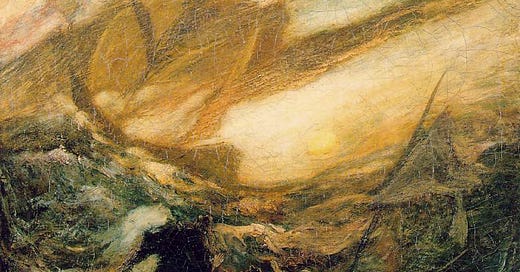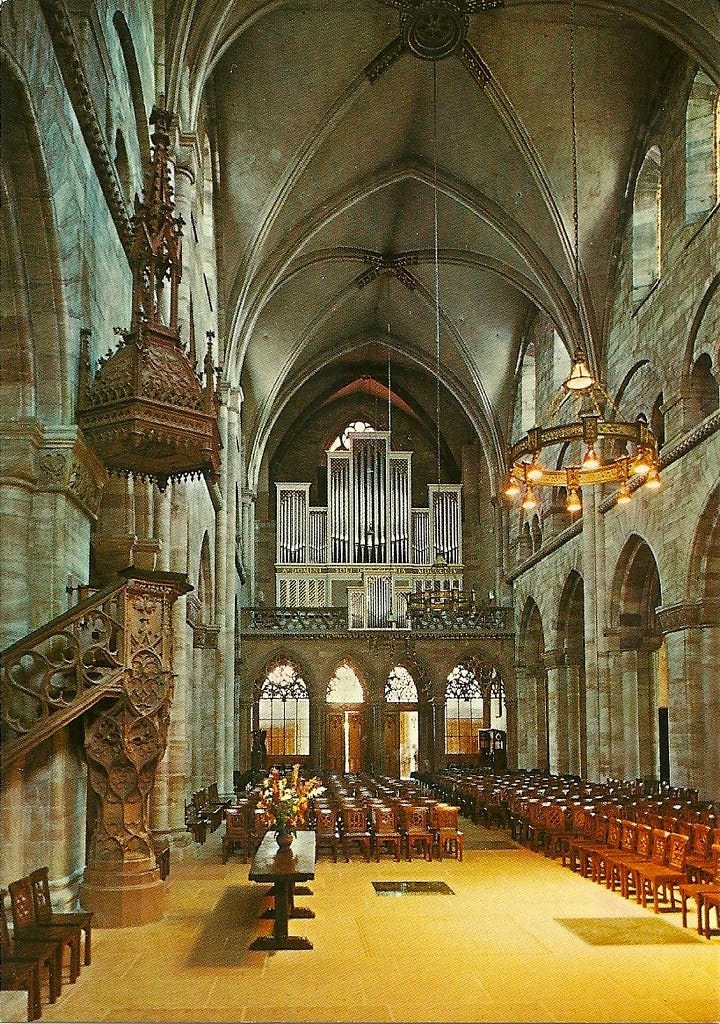Two visions of a fall: the ghost boat and the turd
Two major historical figures and the visions that made them.
I — The Ghost Boat
1881: Prince George of Wales sees the Flying Dutchman
On the deck at four, the future king of England smokes a cigarette in the glowering ocean dark. They’re in the Bass Strait, whose seas are glassy black and strangely calm. He is in that energised state of tiredness in which a man cannot sleep; it is not as though much vexes him, but rather the absence of vexation has pulled him from belowdecks up here, to the creaking rhythms of the sea. It’s 1881 and his face is smooth, catching what little light there is in all the right places. It’s unmistakably him: the big doe eyes his mama calls haunting, just haunting, Georgy and the soft placid mouth. He isn’t like wire-sprung Eddy, coiled asleep below, Eddy of the aquiline nose and witty riposte and arch drawl. He’d be asleep for a while, getting the rest while he could. Dalton would give it to him in the morning; Eddy had been staring glassily all throughout their lessons yesterday, and he remembered Dalton growing suitably vexed. How the devil are you to rule, dullard? he’d heard Dalton grouch from behind his cabin door. Dalton isn’t the only one to think such a thing. George doesn’t think so. Although he couldn’t see his brother crowned, the boy is just sixteen, a little older than he. But, mama said, it takes different boys different times. To each his own, in time.
A whip-crack of shouts. Jolted from his reverie, he sees it. The cigarette falls pinwheeling from his hand, hissing on contact with the deck. Localised in its tip is a red much like the much bigger red he sees now, a pure raw emanation of red light, unearthly red, in the corporeal form of a ship, looming up on the port bow.
“Dutchman!” A cry from the foretopmast. Later, he’ll remember being up there, not so much with but as the ordinary seaman who cried the name of the ship now massive and red and silent.
The cry goes around the boat. Dutchman. The Flying Dutchman.
Amber-trapped, the ship seems to stop, as though it is looking at him. It seems to be singling him out. The ship bucks up in the water, as if to raise and then incline its head. Like it was bowing, he would tell Eddy in the morning.
Eddy.
Eddy who, when they get home will claim he saw it.
Eddy, who everybody said would never be king.
Eddy, whose beautiful white face hardened to marble.
Eddy, wet with fever, whispering with the singular seriousness of the dying, his voice coming from the deep.
And the Dutchman looms up again like a rogue wave.
II – The Turd
1887: Carl Jung sees God in Basel Cathedral
Little Carl loves the cathedral. He loves quiet places. And big quiet places seem even quieter than small quiet places. He thinks it’s because there’s more room for all that quiet to get around. When he goes in, he likes that his feet clack-clack on the stone, echoing up to God, his little sounds allowed and then dwarfed by monumental slabs of Godly silence. Mid-nave, he likes to stop and look up at the Gothic arches, all pointing up to God. That’s the thing with churches: there’s no mistaking what they’re for. They’re there to remind you that you’re tiny and that God is big.
And as he looks up, the ceiling becomes sky. The clouds part and there is God, on a giant throne.
God is really big. Big, Carl realises, in so many ways, most of them beyond language. Later, he will regret not trying harder to look into God’s face, but, even if he did at the time, there’s something about that face that refuses to be known, as though it isn’t the face of God but instead some recessed and perma-unknowable part of the self. But, nonetheless: God, throned, there, above and yet inside Basel cathedral. There he is.
But as Carl looks, what should be awe and ecstasy gives way to a tightening. Yes, that’s it. All the screws of himself being threaded beyond their means, all forces acting brutishly, and he chokes, then. He cannot breathe. His lung mash against his ribcage, which closes like a Venus flytrap. He has to get out. But he knows that now the cathedral is not just without, but within. There is a tiny cathedral inside him. If he runs out of the big one, he will take the little one home.
What caused such a crushing of lung and rib? Only little Carl knows, red-cheeked with sacrilegious shame. But, later, he sees God again, throned, from the Divine Bowels comes a giant and cataclysmic Turd, which does rumble with eschatological thunder as it leaves the Rectum, and does fall upon the cathedral.
III – The Fall
The morning after the Dutchman, things are returning to normal. He is looking at the sun, but some movement in the foreground catches his eye.
A seaman is falling from the foretopmast crosstrees.
George remembers the man’s face as he fell, though he doesn’t quite see how. He would have been too far away. But somehow, it is a part of him now.
Six years later, a boy watches a turd fall. It is beautiful. He remembers every aspect of its topology. There is time. There is always time.
Six years before, a boy watches a man fall. Everything about his face is calm, as though it knew this would happen. As though all of time and space had been revealed in an instant, in that lightening before death.
The turd lands. When it does, it makes no sound at all. But the cathedral crumbles to dust around him. Every atom of it rendered invisible. What was once visible, now invisible.
The man lands. When he does, he makes no sound at all. Later, George will write in his diary that the man was ‘smashed to atoms’.
There is time.
There is never enough time.





